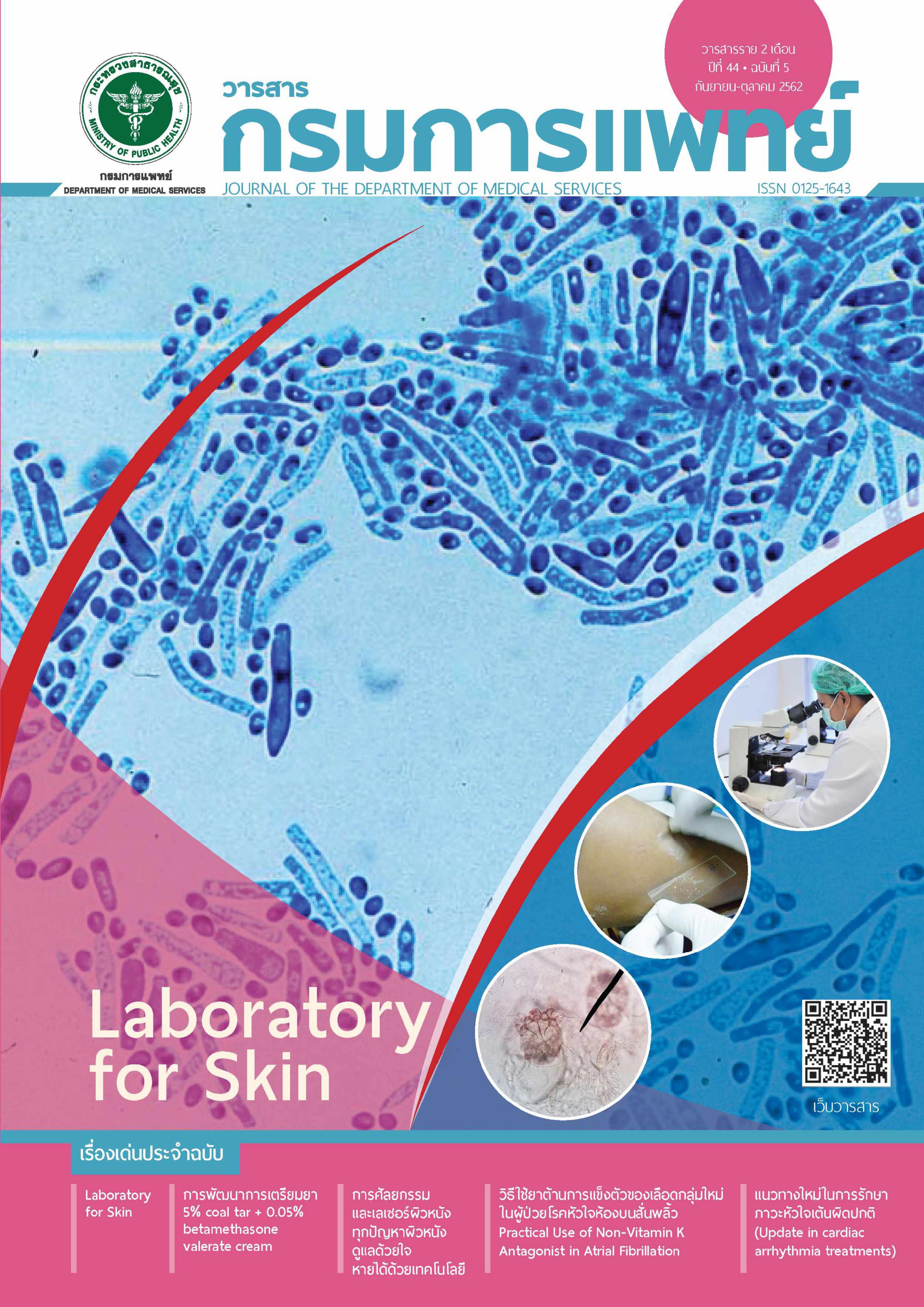Integration of Service Plans for Screening and Reducing High Risk Groups of Cardiovascular Disease, Nakhon Ratchasima, 2017-2018
Keywords:
Cardiovascular risk score, CVD risk management program, Intervention mappingAbstract
This study was to integrate service plans for screening and reducing people with high risk of cardiovascular disease (CVD). Applied research focused on developing programs and investigating the effectiveness of such programs by quasi-experimental study. During January 2017 - June 2018, using the concept of Intervention Mapping (IM) to implement Triple T (Team building, Tool, Targeting) was conducted. The program included a self-care training workshop to prevent CVD in 123 volunteers who had CV risk score> 30%. Family care team did continuity care and home visit. Data were collected before and after 6, 12 months.Most of them were female with age of 70.27 + 6.88 years. At the 6th month, risk groups had more knowledge (P-value <0.001), significantly reduced sweetened consumption behavior (P-value <0.001) and significantly reduced fat consumption behavior (P-value <0.001). At the 12th month, 109 subjects were monitored. Forty three percent changed their higher risk to lower risklevels. In addition, blood cholesterol decreased statistically significant from 187.20 to 182.78 mg/dL (P-value 0.002). No incidence of cardiovascular complications was found.Therefore,we should establish policies to promote the use of this guidance for all people who had CV risk score > 30%.
References
Mendis S, Puska P, Norrving B, editors. Global atlas on cardiovascular disease prevention and control. Geneva World Health Organization; 2011.
World Health Organization. Cardiovascular Diseases (CVDs). Accessed on 10th June 2015. Available from: URL; www. who.int/mediacentre/factsheets/fs317/en/2015.
Preventing chronic diseases a vital invesment. Geneva World Health Organization; 2005.
World Health Organization. Global status report on noncommunicable diseases 2014. Geneva World Health Organization; 2014.
Yusuf S, Hawken S, Oˆ unpuu S, et al. Effect of potentially modifiable risk factors associated with myocardial infarction in 52 countries (the INTERHEART study): case–control study. Lancet 2004; 364: 937–52.
World Health Organization. Global Health Estimates (GHE): World Health Organization; 2000-2012 Accessed on 30th December 2016. Available from : URL ; http://www.who.int/healthinfo/global_burden_disease/en/.
Bureau of Non Communicable Diseases. Annual report 2015. Nonthaburi: Department of Disease Control; 2015.
The 9th regional health of Ministry of Public Health. Annual report 2015. Nonthaburi: Ministry of Public Health; 2015.
Social Medicine Department Maharat Nakhon Ratchasima Hospital. Annual report 2016. Nakhon Ratchasima; 2016.
Karmali KN, Persell SD, Perel P, Lloyd-Jones DM, Berendsen MA, Huffman MD. Risk scoring for the primary prevention of cardiovascular disease. Cochrane Database of Systematic Reviews 2017, Issue 3. Art. No.: CD006887. DOI:10.1002/ 14651858.CD006887.pub4.
Faculty of Medicine Ramathibodi Hospital. Thai CV risk score: Mahidol University. Accessed on 10th June 2015. Available from: URL; http://med.mahidol.ac.th/cvmc/th/thaicv.
Bureau of Non Communicable Diseases. Handbook of data analysis for Thai CV risk score. Department of Disease Control. Nonthaburi: Ministry of Public Health; 2015.
Uthman OA, Hartley L, Rees K, Taylor F, Ebrahim S, Clarke A. Multiple risk factor interventions for primary prevention of cardiovascular disease in low- and middle-income countries. Cochrane Database of Systematic Reviews 2015, Issue 8. Art. No.: CD011163. DOI: 10.1002/14651858 CD011163. pub2.
Cochrane T, Davey R, Iqbal Z, et al. NHS health checks through general practice: randomised trial of population cardiovascular risk reduction. BMC Public Health 2012; 12: 944.
Wister A, Loewen N, Kennedy-Symonds H, et al. One year follow-up of a therapeutic lifestyle interventiontargeting cardiovascular disease risk. CMAJ 2007; 177: 859–65.
Eriksson KM, Westborg CJ, Eliasson MC. A randomized trial of lifestyle intervention in primary healthcare for the modification of cardiovascular risk factors. Scand J Public Health 2006; 34: 453–61.
Fleming P and Godwin M. Lifestyle interventions in primary care: Systematic review of randomized controlled trials. Can Fam Physician 2008; 54: 1706-13.
Solutions for Public Health. International Cardiovascular Disease Prevention case studies. 2018. Accessed on 10th December 2018. Available from: URL; https://www.sph.nhs.uk/wp-content/uploads/2018/11final-cvd-preventionreport-08-oct-18.pdf
Downloads
Published
How to Cite
Issue
Section
License
บทความที่ได้รับการตีพิมพ์เป็นลิขสิทธิ์ของกรมการแพทย์ กระทรวงสาธารณสุข
ข้อความและข้อคิดเห็นต่างๆ เป็นของผู้เขียนบทความ ไม่ใช่ความเห็นของกองบรรณาธิการหรือของวารสารกรมการแพทย์



